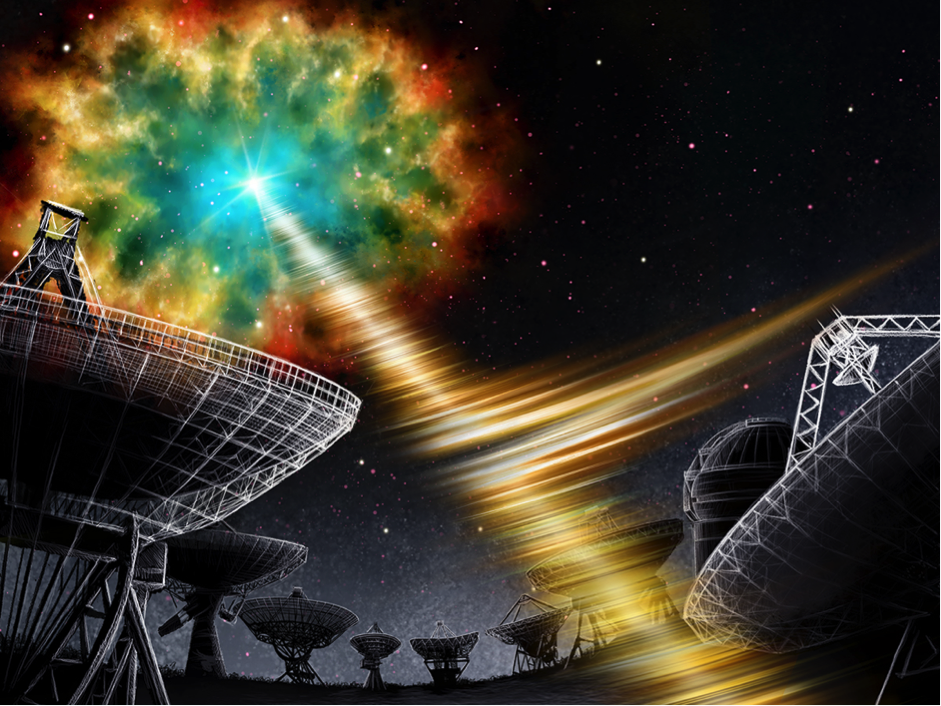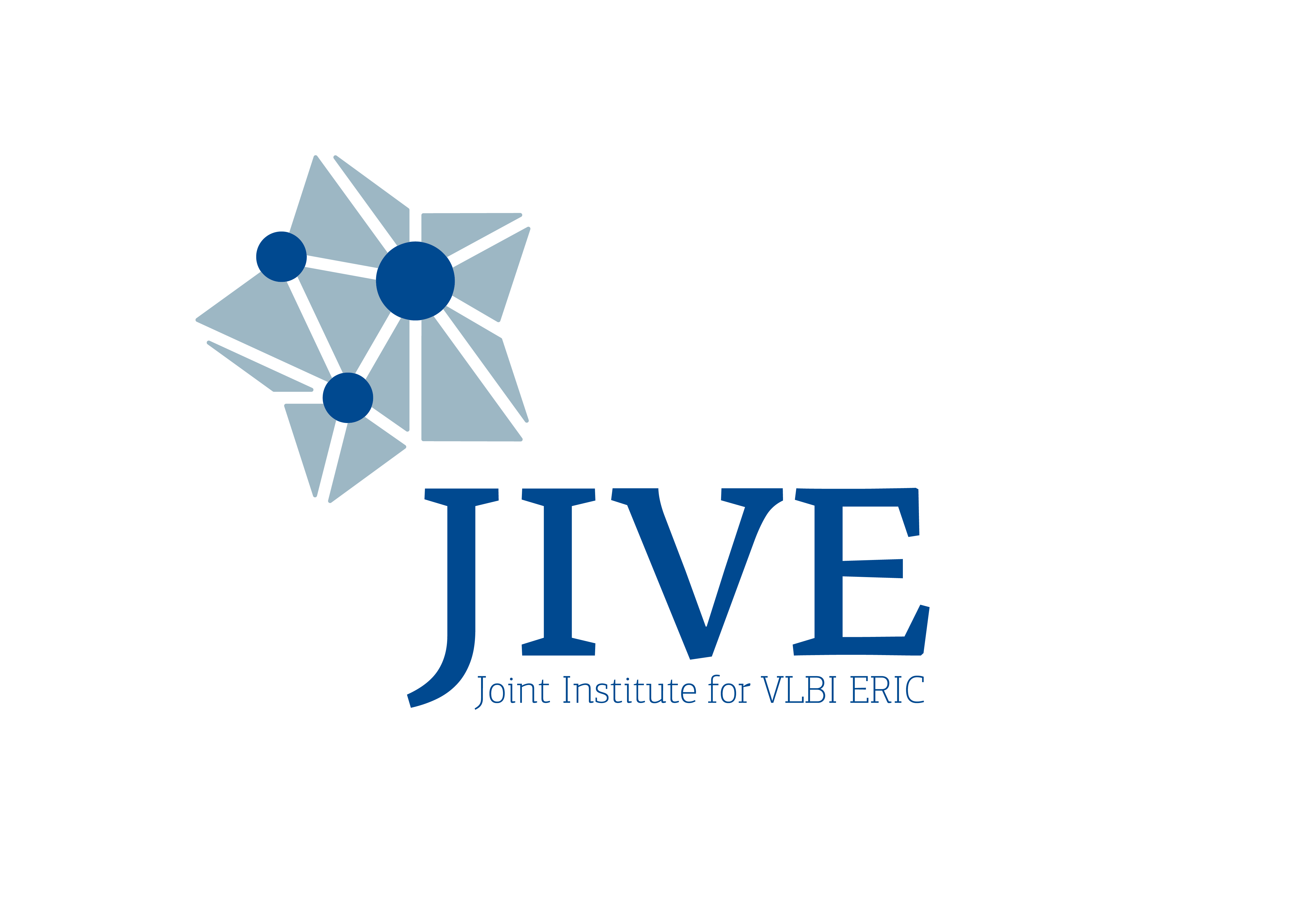
Artist’s impression of FRBs emitted by a source called FRB 20190520B, and originating in a hypernebula (copyright: Daniëlle Futselaar/ASTRON)
A team led by astronomers in the Netherlands have confirmed a repeating FRB source to be linked to a potential "hypernebula" – a dense and highly magnetised cloud of plasma that is illuminated by a powerful but still mysterious source. This confirmation was possible thanks to the use of the European VLBI Network (EVN) and marks the second occasion where an FRB source appears to be powering a hypernebula. The astronomers have published their paper, called Constraints on the persistent radio source associated with FRB 20190520B using the European VLBI Network in The Astrophysical Journal Letters. Read the paper here.
FRBs –fast radio bursts– are brief but intense flashes of radio waves, which last less than the blink of an eye and originate from distant galaxies. While some FRBs are one-off events and are never detected again, others have been observed to repeat. Repeating FRBs are comparatively easy to catch and provide a wealth of information about the objects that produce them.
FRB 20121102A is the first-known repeating FRB and was until recently the only repeating FRB known to be associated with a potential hypernebula.
Small but extremely bright
Now, a team led by astronomers in the Netherlands have confirmed the association of a second FRB source, called FRB 20190520B, with a potential hypernebula. This FRB was discovered using the 500-m FAST telescope in China and appeared to be associated with a more constant source of radio waves (see image below). This more constant source of radio waves hints at a hypernebula powered by the same object that makes the bright radio bursts. Radio waves are a form of light invisible to the naked eye, but which can be detected by specialized instruments, such as radio telescopes. Radio telescopes are so large and sensitive that they can detect astronomical radio waves that travel billions of lightyears before they reach Earth.
The team observed FRB 20190520B using a network of radio telescopes spread across Europe, known as the European VLBI (Very Long Baseline Interferometry) Network or simply “the EVN”. By joining the data of all the dishes located in Germany, Poland, Italy, the Netherlands, Sweden, Latvia, and the United Kingdom, astronomers were able to observe the sky at an extremely high resolution and make super sharp images of the radio light; it is like being able to determine the size of a car on the Moon. Such observations allowed an eagle-eye study of the FRB and its surrounding environment. “With our EVN observations of FRB 20190520B we were able to constrain the size of potential hypernebula to be less than 30 light years in diameter; that’s three times the size of the famous Crab nebula in our own Milky Way galaxy”, says Dr Shivani Bhandari, lead author of the paper and affiliated to ASTRON, the Joint institute for VLBI ERIC (JIVE), the Anton Pannekoek Institute for Astronomy at the University of Amsterdam, and CSIRO Space and Astronomy in Australia. The research team also measured the luminosity of the object to be around a hundred thousand times that of the Sun. It is thus spectacularly energetic.
Radio image of the potential hypernebula powered by the repeating FRB 20190520B. The nebula is billions of lightyears from Earth, but a global network of radio telescopes has placed strong constraints on its size.
Magnetar in a nebula
Astronomers have found evidence that some FRBs may be produced by extremely magnetic neutron stars called "magnetars" (neutron stars are the ultra-dense cores of stars whose core has imploded in a supernova, forming a ball of neutrons with the mass of the Sun, but squished into the size of a city). A magnetar can produce a powerful wind of charged particles that creates a nebulous region in its immediate vicinity. The persistent radio light observed in some FRBs is likely to arise from such a region. Thanks to the newly obtained data, astronomers have constrained the age of this putative magnetar to be between only 4 and 1,900 years old, and that of the nebula to be at least 900 years old. “This observation suggests that there may be a sub-population of young FRB sources embedded in luminous nebulae”, says Bhandari.
Another hypothesis is that the hypernebula is powered by gravitational potential energy, instead of magnetic decay of a magnetar. In this scenario, the bursts are produced within the powerful outflows of a black hole or a neutron star that is "eating" matter from a nearby companion star at devilishly high rates.
Rare type of FRBs
Following FRB 20121102A, FRB 20190520B is just the second FRB to be associated with a potential hypernebula. Dr Benito Marcote, second author of the research paper and affiliated to JIVE: “These FRBs are 'twins' because they are both active repeaters in low-mass dwarf host galaxies and are embedded in extreme and dynamic environments”. These two repeating sources with potential hypernebulae might be showing us the youngest and most energetic FRBs that exist. But, if so, why do we still detect bright radio bursts from much older FRB sources? Astronomers are still struggling to understand the origins of FRBs, but these latest observations provide an important clue to unravelling this mystery. Future observations aim to answer the question whether all FRBs are produced by magnetars, or whether there are multiple types of astronomical objects that can power ultra-bright radio bursts visible from distant galaxies.
Additional information
ASTRON
ASTRON is the Netherlands Institute for Radio Astronomy, ASTRON is part of the institutes organisation of NWO. Our mission is to make discoveries in radio astronomy happen. We do this by developing new and innovative technologies, operating world-class radio astronomy facilities, and pursuing fundamental astronomical research.
Science contact: Shivani Bhandari, email: bhandari@astron.nl
Communications contact: Mischa Brendel, tel: +31(0)521595204, email: brendel@astron.nl
JIVE
The Joint Institute for VLBI ERIC (JIVE) is a research infrastructure, serving as the support centre for the European VLBI Network (EVN). JIVE operates the EVN data processor and offers assistance to astronomers throughout the observational process with the EVN. Its primary goal is to advance the use of Very Long Baseline Interferometry (VLBI) and other radio astronomical techniques. JIVE is headquartered in Dwingeloo, the Netherlands, housed by ASTRON.
The European VLBI Network (EVN) is an interferometric array of radio telescopes spread throughout Europe, Asia, South Africa and the Americas that conducts unique, high-resolution, radio astronomical observations of cosmic radio sources. Established in 1980, the EVN has grown into the most sensitive VLBI array in the world, including over 20 individual telescopes, among them some of the world's largest and most sensitive radio telescopes. The EVN is composed of 13 Full Member Institutes and 5 Associated Member Institutes.
Communications contact: Ioanna Kazakou, tel: +31(0)521596546, email: kazakou@jive.eu
